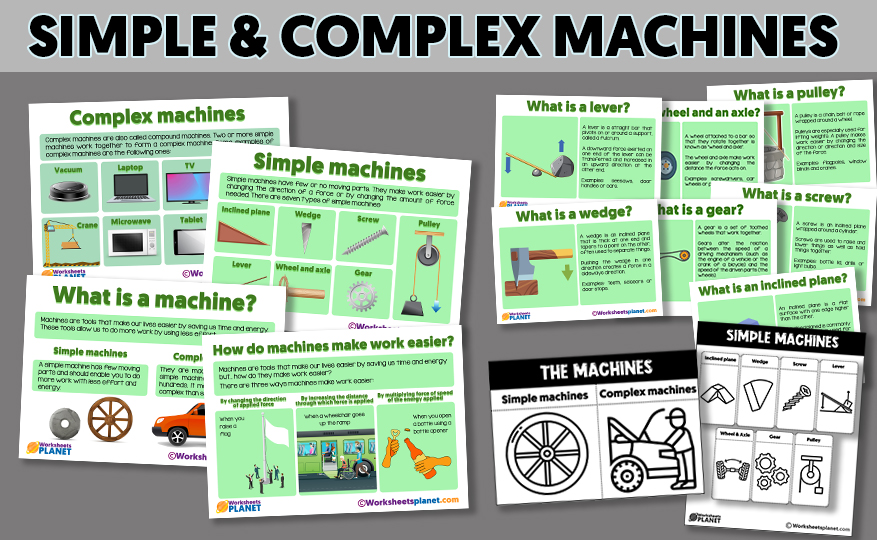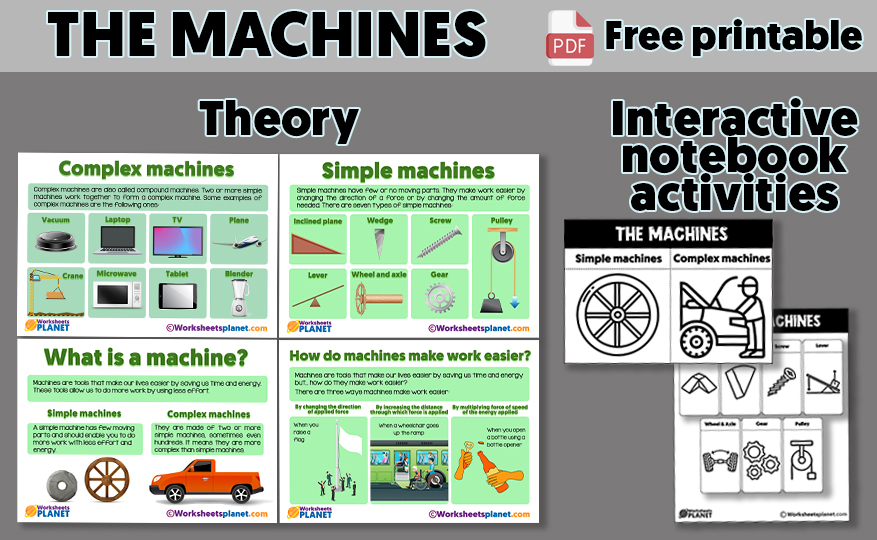Hey Teachers! Simple and complex machines is a very usual topic in our science classes. If you are looking for a simple but complete resource, you’re in the perfect site. This resource contains 13 pages of theory and a few interactive activities for your students’ notebooks. This bundle is for free and you can download it at the end of this post, by clicking on the link.
What is a machine?
Machines are tools that make our lives easier by saving us time and energy. These tools allow us to do more work by using less effort.
A simple machine has few moving parts and should enable you to do more work with less effort and energy.
Complex machines are made of two or more simple machines, sometimes even hundreds. It means they are more complex than simple machines.

How do machines make work easier?
Machines are tools that make our lives easier by saving us time and energy but… how do they make work easier? There are three ways machines make work easier:
- By changing the direction of applied force, e.g. when you raise a flag.
- By increasing the distance through which force is applied, e.g. when a wheelchair goes up a ramp.
- By multiplying force of speed of the energy applied, e.g. when you open a bottle using a bottle opener.
What is a simple machine?
Simple machines have few or no moving parts. They make work easier by changing the direction of a force or by changing the amount of force needed. There are seven types of simple machines:
- An inclined plane is a flat surface with one edge higher than the other. The inclined planed is commonly known as ramp. It is used for raising heavy bodies. Examples: stairs, hills or wheelchair ramps.
- A screw is an inclined plane wrapped around a cylinder. Screws are used to raise and lower things as well as hold things together. Examples: bottle lid, drills or light bulbs.
- A gear is a set of toothed wheels that work together. Gears alter the relation between the speed of a driving mechanism (such as the engine of a vehicle or the crank of a bicycle) and the speed of the driven parts (the wheels). Examples: bikes, drills or non-digital clocks.
- A wedge is an inclined plane that is thick at one end and tapers to a point on the other, often used to separate things. Pushing the wedge in one direction creates a force in a sideways direction. Examples: teeth, scissors or door stops.
- A pulley is a chain, belt or rope wrapped around a wheel. Pulleys are especially used for lifting weights. A pulley makes work easier by changing the direction or direction and size of the force. Examples: flagpoles, window blinds and cranes.
- A wheel attached to a bar so that they rotate together is known as “wheel and axle”. The wheel and axle make work easier by changing the distance the force acts on. Examples: screwdrivers, car wheels or pizza cutters.
- A lever is a straight bar that pivots on or around a support, called a fulcrum. A downward force exerted on one end of the lever can be transferred and increased in an upward direction at the other end. Examples: seesaws, door handles or oars.

What is a complex machine?
Complex machines are also called compound machines. Two or more simple machines work together to form a complex machine. Some examples of complex machines are the following ones: vacuum, TV, laptop, crane, plane, tablet, microwave or blender.

